




20 Cork Street London W1S 3HL +44 (0)20 7734 1732 info@redfern-gallery.com redfern-gallery.com
Inscape
Gouache on

Roy Turner Durrant (1925-98) liked to be addressed by his full name, particularly relishing ‘Turner’ with its reference to one of England’s greatest artists. In order to avoid constant repetition of this splendid mouthful, the following essay relies as others have done on his initials alone: RTD. Abbreviating his name does not, of course, necessitate a diminution of attention to his work, though it’s clear that there are secrets still to be unravelled about his drawings and paintings which this short introduction can only begin to hint at.
Although the visual language that RTD used is typical of his time, his personal frame of reference remains altogether more opaque. There is a mystery at the heart of his endeavour — or perhaps a self-constructed mysteriousness. A profoundly literary artist, whose inspiration was fed by the writings of Gerard Manley Hopkins, Thomas Hardy, James Joyce and Samuel Beckett amongst others, RTD was himself a poet, publishing a volume of poems entitled A Rag Book of Love in 1960 (Scorpion Press). He professed to being influenced by literature more than art, and he wrote a
great deal in notebooks, journals and letters. He thought of the titles of his pictures as poetry, to suggest rather than describe. He aimed to penetrate beyond ‘the merely visual’.
There are parallels between his work and his European contemporaries, especially those of a ‘tachiste’ or ‘art informel’ tendency. For instance, RTD’s work compares interestingly with that of the Italian-Swiss painter Luigi Pericle (1916-2001) who was exhibiting in the UK in the 1960s, with solo shows at Arthur Tooth & Sons. It doesn’t particularly matter whether RTD actually saw Pericle’s work or not: there was a feeling in the air of the 1950s and 60s which made such work possible, and indeed inevitable, for both artists. The same recourse to certain common structures can be found in the drawings of Eduardo Paolozzi, or the etchings of Geoffrey Clarke. All are a response to the zeitgeist, the defining spirit or mood of the period. Spirit is an appropriate word for RTD, who said he was not painting places so much as the spirit of a particular place, the Inscape. A term he borrowed from Gerard Manley Hopkins, ‘Inscape’ is a difficult notion to pin
down. It is very much concerned with individuality and uniqueness, and the expression of an inner core or essence of things, their distinctive design and intrinsic beauty.
RTD was nothing if not individualistic. Born in Lavenham the son of a cobbler, he was another Suffolk Neo-Romantic artist, like Alan Reynolds, who moved away from representation towards a more abstract and radical idiom. He drew from a very early age, mostly aeroplanes and flying machines. It is revealing that his first subject was flight, and that he spent so much of the rest of his life in retreat from the world; certainly from the art world.
After wartime service in the Suffolk Regiment, from 1948 to 1952 he studied at Camberwell School of Arts & Crafts, under such teachers as William Coldstream and Victor Pasmore, though he felt closer to the part-time tutors Michael Rothenstein, John Minton and Keith Vaughan. He had hated the army, but even at liberal art school he was ill at ease. At this point he was more drawn to a Neo-Romantic vision than to the abstraction that Pasmore was just espousing. In 1950, while still a student, he had a solo exhibition at Helen Lessore’s prestigious Beaux Arts Gallery. This was a considerable accolade. Lessore had an enviable reputation for spotting winners: among the artists she showed
were Craigie Aitchison, Michael Andrews, Frank Auerbach and Leon Kossoff.
RTD took various jobs to support his family, but painted and drew in every spare moment, before turning to painting full-time in 1976. Although he had many solo shows and contributed to countless mixed exhibitions, he never attended any of them and spent most of his time in a chalet studio at the bottom of his garden. Even his family saw little of him and he never discussed his art with them. He showed widely in the 1950s and 60s, but the 70s and 80s were a lean time for him, his work neglected and out of fashion. When Irving Grose of the Belgrave Gallery began far-sightedly to promote RTD’s work in the 1990s he found him extraordinarily elusive. He refused to answer the phone or show his work to dealers, and all negotiations had to be conducted by letter. Grose comments: ‘It appeared that no-one from the art world had ever met RTD.’
Although he claimed to look at very little art by others, he was clearly aware of developments in modern painting. His work reveals a major debt to Cubism, but the presiding genius and major inspiration must be Paul Klee. The interplay between abstraction and representation is crucial here, most particularly
to be found in an exquisite group of small works on paper from 1957. Displaying the utmost diversity within their accepted structures, and virtuosity in the ordering of line and colour, these are beautiful and intricate skeins of lines mapping the universe. The fertility of interpretation is astonishing.
Here is a kind of seething inventiveness wielded with supreme control behind a complex yet exact ink line and the telling disposition of colour masses. RTD was actually more painterly than one might expect of an artist who is often praised for his spiky draughtsmanship. His drawings and paintings are not just about structure, but about the interaction of form and colour, and the application of paint. The phrasing of his work, the placement of forms and the intervals between them, is always beautifully realised and often visually intriguing. It is not easy to explain, and until more research is carried out into the wellsprings of RTD’s imagination, his work is best simply experienced.
These hard-edged patterns with breaks of colour like mosaic tesserae, recall the urban webs of the Portuguese abstractionist Vieira da Silva (1908-92). RTD’s vision is altogether more pastoral and earthy, also more speculative. There are echoes of Roger Hilton in some of the more obviously sexual or interpenetrating
shapes, though RTD had his own admiration for the female body without borrowing someone else’s obsession. He painted and drew heads frequently, often presented against a dark ground. They are not portraits or self-portraits so much as metaphors for the human condition. An exception is the Klee-like Self with Pipe from 1973. Such parallels are not intended to suggest that RTD was influenced by these artists; more that they make up the artistic context in which he worked, as very much a painter of his times.
Ars longa, vita brevis is carved on his gravestone in Lavenham churchyard. Literally translated as ‘art is long, life short’, the phrase was in fact intended to mean that learning one’s art or craft took so long that a lifetime might not be enough. But it also holds within its four-word formula the comforting thought that works of art outlive their creators. Roy Turner Durrant certainly believed this, and the continuing and increasingly widespread interest in his work would seem to confirm it.
AL 2022
Painting: 9 Dec, 1954


Oil on panel 21 x 27.5 cm
Landscape Near Lavenham, 1953
Mixed media on paper 25 x 30.5 cm
Head with Red, 1955
Oil on paper laid on panel 41.5 x 38 cm

Untitled, 1957
Gouache on paper 20.4 x 12.4 cm
Untitled, 1957
Gouache on paper 20.2 x 12.6 cm
Composition with Yellow, 1957

Mixed media on paper 20.1 x 12.5 cm
Untitled, 1957


Mixed media on paper 20 x 12.5 cm

Purple with Blue Forms, 1957


Mixed media on paper 20.2 x 12.5 cm
Untitled, 1957
Mixed media on paper 20.2 x 12.6 cm
Composition (233), 1957


Mixed media on paper 20 x 12.1 cm
Untitled, 1957
Mixed media on paper 20 x 12.5 cm
Vertical Composition, 1959
Gouache on paper 21 x 12.7 cm
Vertical Composition, 1957


Mixed media on paper 20.2 x 12.6 cm
Inscape (Black and Pink), 1957


Gouache on paper 12.5 x 20.2 cm
Inscape, 1957
Mixed media on paper 12.5 x 20.2 cm
Untitled with Crimson and Blue, 1957

Mixed media on paper 20.2 x 12.4 cm
Vertical Composition (Blue), 1957

Gouache on paper 20.1 x 12.5 cm
Untitled, 1957 Gouache on paper 20.2 x 12.5 cm

Composition with Blue, 1957
Gouache on paper 20.1 x 12.5 cm

Twenty-Two Constructions, 1962

Mixed media on paper 57 x 52.5 cm
Nine Heads, 1962
Mixed media on paper 57.3 x 49.5 cm

Large Head (Brown Background), 1974
Mixed media on paper 76 x 55.5 cm

The Way In (Inscape), 1963


Mixed media on paper laid on thin card 42 x 34.5 cm
Inscape (Marie Alder Throughway), 1980
Mixed media on paper 29.5 x 41.5 cm
Untitled, 1955
Mixed media on paper 20.5 x 12.8 cm

Self with Pipe, 1973
Mixed media on paper 30 x 21 cm
Inscape (Vertical), 1957

Gouache on paper 20.2 x 12.6 cm

Untitled (236), 1957



Mixed media on paper 12.5 x 20.1 cm
Inscape with Red, 1957

Gouache on paper 12.7 x 20 cm
Mixed media on paper 20.3 x 12.5 cm
Untitled, 1957
Gouache on paper 20 x 12.5 cm
Composition with Blue and Black, 1957

Gouache on paper 20.2 x 12.5 cm
Untitled with Yellow, 1957 Gouache on paper 20.2 x 12.5 cm

Inscape with Plant Forms (IX), 1954
Mixed media on paper 12.7 x 20 cm
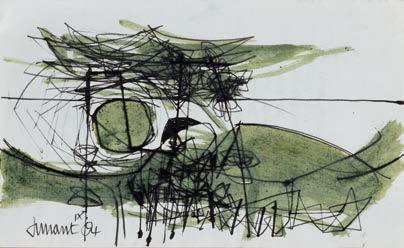
Sensitive Plants (3CR.397.1955), 1955
Gouache on paper 20.2 x 12.5 cm
Vertical Composition (3CR 466/1955), 1955
Gouache on paper 20.2 x 12.4 cm
Untitled (3CR 512/1955), 1955




Gouache on paper 20.2 x 12.4 cm
Composition with Black (1955.3CR.386), 1955
Mixed media on paper 20.2 x 12.7 cm
Untitled (1955.3CR.362), 1955
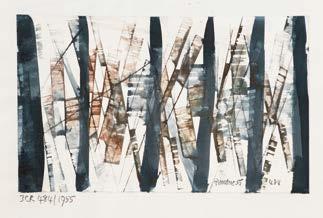
Gouache on paper 20 x 12.7 cm
Blue Forms (3CR 484/1955), 1955
Gouache on paper 12.5 x 20.5 cm
Inscape with Hill Forms, 1957
Mixed media on paper 7.9 x 12.2 cm
Untitled (3CR 483/55), 1955

Gouache on paper 12.4 x 20.2 cm
Landscape (3CR 452/55), 1955

Watercolour on paper 12.6 x 20.3 cm
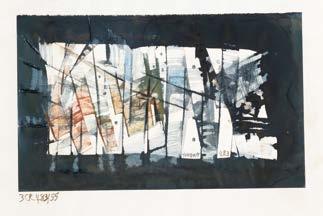


Head, 1962

Mixed media on paper 50 x 32.5 cm

Grey Head, 1963
Mixed media on paper 42 x 34.5 cm
Vertical Forms, 1959

Gouache on paper 20.2 x 12.6 cm
Inscape: Sunset, c.1955
Mixed media on paper 12.4 x 20.2 cm
Untitled (Pink and Yellow), 1957


Gouache on paper 12.5 x 20.4 cm
Inscape: Sunrise, 1957
Gouache on paper 12.3 x 20 cm

Dark Inscape, 1957
Gouache on paper 12.5 x 20.2 cm
Inscape with Pink, 1957

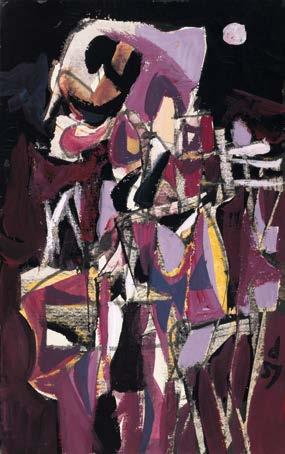
Mixed media on paper 12.5 x 20.2 cm
Inscape: Night, 1957
Mixed media on paper 20.1 x 12.5 cm
Composition with Blue and Yellow, c.1957
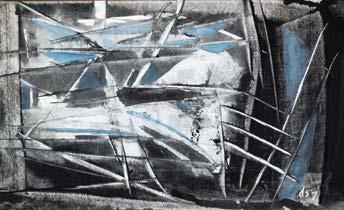
Mixed media on paper 20.2 x 12.5 cm

Composition with White, 1959
Mixed media on paper 25 x 18.8 cm
Untitled, 1957
Mixed media on paper 20 x 25 cm
Inscape with Blue, 1957

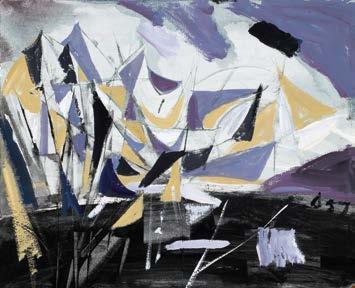
Gouache on paper 17.7 x 25 cm

Abstract Landscape, 1959

Gouache on paper 18.7 x 25 cm
Abstract Form (274), 1957
Mixed media on paper 27.8 x 19 cm

Composition, 1957
Mixed media on paper 25 x 20.3 cm

Gouache on paper 20 x 25 cm

Pale Inscape (266), 1957
Gouache on paper 19 x 28.2 cm
Untitled (262), 1957



Gouache on paper 19 x 27.5 cm
Horizontal Form (269), 1957
Mixed media on paper 17.6 x 24.2 cm
Front cover detail of:
Inscape, 1957 illustrated fully on page 10
Inside front cover detail of: Untitled (Pink and Yellow), 1957 illustrated fully on page 22
Inside back cover detail of:
Head with Red, 1955 illustrated fully on page 7
Back cover detail of: Inscape (Black and Pink), 1957 illustrated fully on page 10
Published by The Redfern Gallery, London 2022 ISBN: 978-0-948460-94-4
All rights reserved. No part of this book may be reproduced or transmitted in any form or by any means, electronic or mechanical, including photocopying recording or any other information storage or retrieval system without prior permission in writing from the gallery.
20 Cork Street London W1S 3HL +44 (0)20 7734 1732 info@redfern-gallery.com redfern-gallery.com

